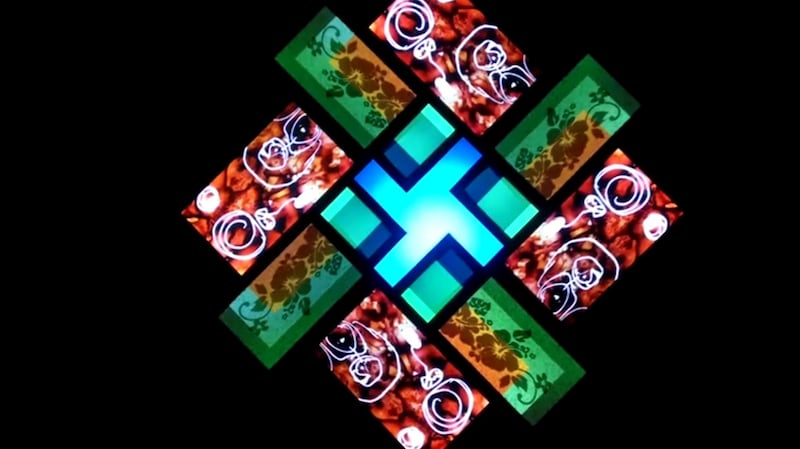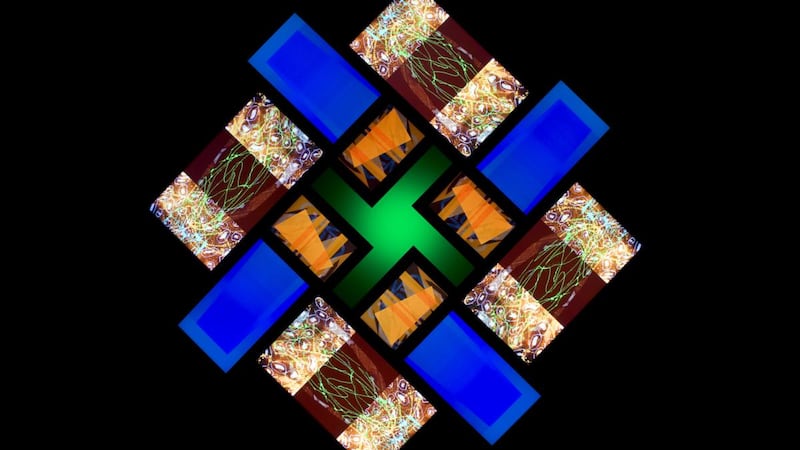In the hours before the opening of his exhibition 77 Million Paintings at the RHA in Dublin, Brian Eno was to be found manoeuvring a vacuum cleaner around the floor of the sparse installation of spindly tree trunks that forms the setting for his sound and moving image epic, which unfolds on a large projection screen.
His technical team had been in town for the best part of a week. Preparations included building a large temporary wall, a projection screen rather than a barrier, which also houses what he terms “a fairly serious sound system”.
The number specified in the title is not a definitive estimate. One feels the real number might be close to infinity. At the heart of the work is a computer programme with a cache of hundreds of image and audio building blocks at its disposal.
In a continual sequence of fades, in and out, the programme combines elements of four of the images, accompanied by a constantly changing soundtrack. Intensely coloured, the images mutate against a constant symmetrical template, and both sound and image proceed at quite a slow, hypnotic pace.
Nothing happens suddenly, but no image is ever fixed and static, it is always becoming something else.

“It’s always changing,” Eno says, “and it is slow, deliberately so. You know this notion that we’re all supposed to process stuff faster and faster and can’t fix our attention on anything for more than an instant?” He shakes his head. “It’s not true.”
Technology does tend to encourage this view. He mentions the contemporary cultural tendency to speed through museums, barely pausing for selfies and snapshots of what you’re supposed to be looking at.
“For me, using music is a way of saying to the visitor that this thing happens in time, it’s a way of saying: settle down. Once you hear music you know this is going to take a while. And then the images change, but they change really gradually. You’re trying to encourage people to adjust to the speed of the work.”
That does run a risk. “Some people find it boring and get uneasy. You have to slow down. But we’ve found that people are capable of doing that. It’s pleased me that people have described spending hours looking at the work. It’s an underestimation of people to feel that their attention spans have disappeared. I mean, the long form has a place in contemporary culture. Look at 10-hour Netflix dramas that people consume in blocks, hours at a time. And you will find those dramas are not all frenetic action. They contain long, sumptuous scenes in which not much is happening.”
He was immediately keen when RHA director Pat Murphy proposed staging 77 Million Paintings. More than 30 years ago he'd staged a video and soundscape at the Douglas Hyde Gallery when Murphy was director there, and enjoyed the experience.
He has returned on various occasions since for a variety of reasons – he is a Renaissance man whose solo career in art and music would be more than enough in itself, but has been paralleled by numerous high-profile collaborations and his work as an album producer.
“Although I’ve never actually lived in Ireland for any length of time, I was thinking recently that I’ve spent longer in Ireland than I have anywhere else apart from the UK and the United States – I lived in New York for about five years at one point. Putting together all my time spent in Ireland comes to about two and a half years.”
Many iterations
The crafting of 77 Million Paintings has developed consistently. A great deal of work has gone into each new iteration – and there have been many. As with the images, "the units of sound are combinable in different ways. It's important that any one piece doesn't have too much personality."
If it did so, the listener would tend to focus on it as a motif. Whereas personality should emerge cumulatively from the experience.
“The same applies to the images. That’s why there are very few figurative images – there are a few, just a glimpse of a face here and there, things like that, though not very obviously. Too clear an image would take over. I think of both images and sounds as being high valency: they can connect up with other bits in lots of ways.”

In that regard, Eno has learned from the work as he’s spent time with it. When it was first launched in Japan in 2006, the programme could draw on 296 original images, mostly painted on glass by Eno. “There’s more than that now,” he notes. At several stages he’s adjusted the content, removing some and adding more. “It’s funny, with any given image you only see how it’s going to work when it’s in the system, and it can take quite a long time to realise that one or other does something really good.
“There’s one that’s been there from the start that is particularly good. It’s just a pattern of curving white lines but whenever it appears it seems to really inject life into it.”
He enjoys being surprised by the alchemy of the combinations. “You think you know, but you find you don’t. There’s a magic about that. It’s sort of counter-intuitive. Like watching a magic act. You follow the logic of the magician’s movements and then he suddenly pulls a rabbit out of a hat.”
Brian Eno’s 77 Million Paintings is running at the Gallagher Gallery in the RHA, Ely Place, Dublin until February 24th. rhagallery.ie













